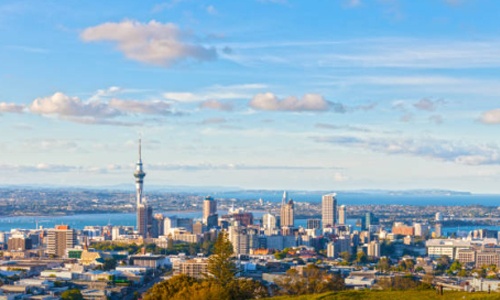
Australasia
AUSTRALIA
Australia is a wealthy country with a market economy, a relatively high GDP per capita, and a relatively low rate of poverty. In terms of average wealth, Australia ranked second in the world after Switzerland, and the nation’s poverty rate increased from 10.2 per cent to 11.8 per cent. It was identified by the Credit Suisse Research Institute as the nation with the highest median wealth in the world and the second-highest average wealth per adult. Ranked third in the Index of Economic Freedom, Australia is the world’s twelfth largest economy and has the fifth highest per capita GDP (nominal). The country was ranked second in the United Nations Human Development Index and first in Legatum’s Prosperity Index.

Melbourne, Australia
Melbourne has a highly diversified economy with particular strengths in finance, manufacturing, research, IT, education, logistics, transportation and tourism. Melbourne is headquarters for many of Australia’s largest corporations, including five of the ten largest in the country (based on revenue), and four of the largest six in the country (based on market capitalisation) (ANZ, BHP Billiton (the world’s largest mining company), the National Australia Bank and Telstra); as well as such representative bodies and think-tanks as the Business Council of Australia and the Australian Council of Trade Unions. The city is home to Australia’s largest Melbourne 1and busiest seaport which handles more than $75 billion in trade every year and 39% of the nation’s container trade. Melbourne Airport provides an entry point for national and international visitors, and is Australia’s second busiest airport. Melbourne is also an important financial centre. Two of the big four banks, NAB and ANZ, are headquartered in Melbourne. The city has carved out a niche as Australia’s leading centre for superannuation (pension) funds, with 40% of the total, and 65% of industry super-funds including the $40 billion-dollar Federal Government Future Fund. The city was rated 41st within the top 50 financial cities as surveyed by the MasterCard Worldwide Centers of Commerce Index, second only to Sydney (12th) in Australia. Melbourne is Australia’s second-largest industrial centre. It is the Australian base for a number of significant manufacturers including Boeing, truck-makers Kenworth and Iveco, Cadbury as well as Bombardier Transportation and Jayco, among many others. It is also home to a very wide variety of other manufacturers, ranging from petrochemicals and pharmaceuticals to fashion garments, paper manufacturing and food processing. The city also boasts a research and development hub for Ford Australia, as well as a global design studio and technical centre for General Motors and Toyota respectively.

Sydney, Australia
As the financial, manufacturing and economic hub of Australia, Sydney has grown to become a wealthy and prosperous city and its residents enjoy the world’s second highest earnings when measured using domestic purchasing power, among world cities. The largest economic sectors in Sydney, as measured by the number of people employed, include property and business services, retail, manufacturing, and health and community services. Sydney provides approximately 25 percent of the country’s total GDP. The Australian Securities Exchange and the Reserve Bank of Australia are located in Sydney, as are the headquarters of 90 banks and more than half of Australia’s top companies, and the regional headquarters for around 500 multinational corporations. Of the ten largest corporations in Australia by revenue, four have headquarters in Sydney: Caltex Australia, the Commonwealth Bank, Westpac, and Woolworths. Of the 54 authorised deposit-taking banks in Australia, 44 are based in Sydney including nine of the 11 foreign subsidiary banks in Australia and all of the 29 local branches of foreign banks. Major authorised foreign banks in Sydney include Citigroup, UBS Australia, Mizuho Corporate Bank, HSBC Bank Australia and Deutsche Bank.
NEW ZEALAND
New Zealand has a modern, prosperous and developed market economy with an estimated gross domestic product (GDP) at purchasing power parity (PPP) per capita of roughly US$28,250. The currency is the New Zealand dollar, informally known as the “Kiwi dollar”; it also circulates in the Cook Islands, Niue, Tokelau, and the Pitcairn Islands. New Zealand was ranked sixth in the Human Development Index, fourth in the Heritage Foundation’s Index of Economic Freedom, and 13th in INSEAD’s Global Innovation Index.

Auckland, New Zealand
Most major international corporations have an Auckland office, as the city is the economic capital of the nation. The most expensive office space is around lower Queen Street and the Viaduct Basin in the Auckland CBD, where many financial and business services are located, which make up a large percentage of the CBD economy. A large proportion of the technical and trades workforce is based in the industrial zones of South Auckland. The largest commercial and industrial areas of Greater Auckland are in the southeast of Auckland City and the western parts of Manukau City, mostly bordering the Manukau Harbour and the Tamaki River estuary. The sub-national GDP of the Auckland region is estimated at US$47.6 billion, 36% of New Zealand’s national GDP, 15% greater than the entire South Island. Auckland’s status as the largest commercial centre of the country reflects in the high median personal income (per working person, per year) which is NZ$44,304 (approx. US$33,000) for the region, with jobs in the Auckland CBD often earning more. The median personal income is NZ$22,300, behind only North Shore City (also part of the Greater Auckland area) and Wellington. While office workers still account for a large part of Auckland’s commuters, large office developments in other parts of the city, for example in Takapuna or Albany, both on the North Shore, are slowly becoming more common, reducing concentration on the Auckland CBD somewhat.





